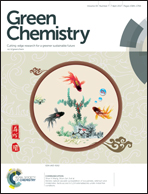CO2-modified solvents for chromatographic separation†
Abstract
Developing alternatives to organic solvents and salts in chromatographic separation is highly desired. CO2 is abundant, inexpensive, nontoxic, environmentally benign, and easily removed. In this work, the impact of CO2-modified aqueous solvents on reversed phase chromatographic separation is studied. A robust custom CO2 delivery system (1 bar CO2) is able to provide CO2-modified aqueous solvent with pH 3.9–6.5. A significant hydrophobicity switch of the stationary phase was observed by a reduction in the retention factor, k, when using CO2-modified solvents for the diethylaminoethyl (tertiary amine) and polyethylenimine (primary, secondary and tertiary amine) functionalized columns. In particular, the polyethylenimine column can be used to perform separation with 100% water without any organic solvent added. Carboxymethyl based columns were not switched by CO2-modified solvent, indicating the need for more significant pH change. The CO2 triggered selectivity switch resulting from analyte ionization provides an important tool in controlling the selectivity of separation. Overall, CO2-modified solvent is valuable in tuning the elution strength and selectivity of reversed phase chromatography.



 Please wait while we load your content...
Please wait while we load your content...